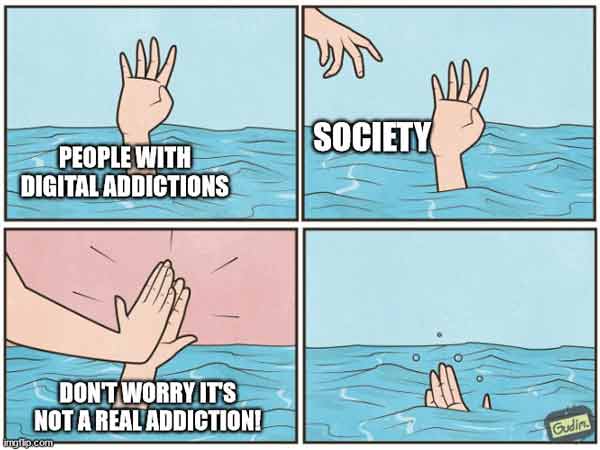Welcome to our digital detoxing series! A series on how to stop addictions to Fortnite,Facebook,Instagram,porn,Netflix, Youtube,Tinder… Find all the posts about digital addiction. Today, let’s talk about how to quit the converse addiction.

- What’s the converse addiction?
- Addiction to converse, a “real” addiction?
- What’s considered converse addiction
- How much converse is too much?
- Some technology addiction facts & statistics
- Symptoms & Causes of the converse addiction
- Why is converse so addictive?
- Possible causes of converse dependency
- Symptoms, Causes and Signs of converse addiction
- Problems, impacts & bad effects of converse
- Some benefits of converse
- health problems
- impact on brain & mental health
- impact on relationships
- How to stop & quit your converse addiction
- Main steps and solutions to break the converse addiction
- Best converse blocker apps & functionalities
- where to seek extra help?
- Conclusion
- To Go Further
- How to help someone with converse addiction
- Best books about technology addiction
- Research about technology addiction
What is the converse addiction?
About converse
Converse is a shoe brand, known for its classic Chuck Taylor All-Star sneakers, and is owned by Nike.
Addiction to converse, a “real” addiction?
Officially an addiction?
First, let’s have a look to the DSM-5,the Diagnostic and Statistical Manual of Mental Disorders. Does it includes converse addiction?
No, converse addiction or shoe addiction is not listed as a specific diagnosis in the DSM-5 (Diagnostic and Statistical Manual of Mental Disorders, 5th edition) or any other official diagnostic classification system. However, excessive buying or collecting of shoes or other items can be a symptom of a broader mental health condition such as obsessive-compulsive disorder, hoarding disorder, or impulse control disorder. If someone is experiencing significant distress or impairment in their daily life due to their shoe buying or collecting behavior, they should seek the help of a mental health professional.
So what means “converse addiction”?
Converse addiction refers to an obsession or compulsion to collect and wear Converse shoes, often to the point where it interferes with daily life or becomes financially burdensome. It is a type of behavioral addiction that can lead to negative consequences such as social isolation, financial strain, and decreased self-esteem.
What is considered converse addiction?
We can provide general information about addiction.
It is essential to understand that addiction is a complex condition that affects individuals differently. There is no one-size-fits-all method for diagnosing addiction, and it is essential to consult a qualified healthcare professional for proper diagnosis and treatment.
That being said, here are some general criteria that healthcare professionals may consider when diagnosing an addiction:
- 1. Loss of control:The individual is unable to stop using the substance, even when they want to.
- 2. Withdrawal symptoms:The individual experiences physical and/or emotional symptoms when they stop using the substance.
- 3. Tolerance:The individual needs to use more of the substance to achieve the same effect.
- 4. Negative consequences:The individual continues to use the substance, despite experiencing negative consequences (e.g., health problems, legal problems, relationship problems).
- 5. Preoccupation:The individual spends a significant amount of time thinking about, obtaining, and using the substance.
- 6. Interference with daily life:The individual’s use of the substance interferes with their ability to fulfill their responsibilities at work, school, or home.
Again, it is crucial to seek professional help for proper diagnosis and treatment of addiction.
How much converse is too much?
There is no specific time limit for a conversation, but it is essential to be mindful of the other person’s time and interest in the conversation. It is always best to be respectful of the other person’s time and to end the conversation when it feels like it has run its course or when the other person shows signs of disinterest.
Some technology addiction facts & statistics

Technology addiction is a growing concern in today’s world. Here are some statistics related to technology addiction:
- 1. According to a 2019 survey by Common Sense Media,50% of teens feel addicted to their mobile devices.
- 2. A study conducted by the Pew Research Center found that 28% of adults in the US feel they are constantly online.
- 3. A survey conducted by the American Psychological Association found that 43% of Americans are constantly checking their electronic devices for email, texts, or social media updates.
- 4. A survey conducted by the Royal Society of Public Health in the UK found that social media is the most addictive technology,with 63% of respondents reporting that they check their social media accounts at least once a day.
- 5. In a study conducted by the University of Maryland,students were asked to give up all technology for 24 hours. Many of the participants experienced withdrawal symptoms such as anxiety, irritability, and even physical symptoms such as headaches.
- 6. A study conducted by the University of Gothenburg in Sweden found that excessive use of mobile phones can lead to sleep disorders,depression, and anxiety.
- 7. According to the World Health Organization,internet addiction disorder (IAD) is a real condition that can have serious negative consequences on an individual’s mental and physical health.
Is the converse addiction widespread?
Converse shoes are a popular brand with a loyal following, and some people may have a strong affinity or collection of Converse shoes. It is important to note that addiction is a serious issue that requires professional help and should not be trivialized.
Symptoms, Causes and Signs of converse addiction
Why is converse so addictive?
Converse shoes may be addictive for several reasons:
- 1. Comfort:Converse shoes are known for their comfortable fit, which can make them a go-to choice for many people.
- 2. Versatility:Converse shoes come in a variety of colors and styles, making them easy to pair with different outfits.
- 3. Nostalgia:Converse shoes have been around for decades and have been worn by many iconic figures, which can evoke feelings of nostalgia and make them more appealing.
- 4. Brand loyalty:Some people develop a strong attachment to the Converse brand and seek out their products as a way of expressing their loyalty.
- 5. Social connection:Converse shoes have become a cultural icon and can be a way for people to connect with others who share their love for the brand.
Possible causes of converse dependency
There are several factors that can contribute to converse addiction, including:
- 1. Social pressure:Peer pressure or a desire to fit in with a certain group can lead to excessive buying and wearing of Converse shoes.
- 2. Emotional attachment:Some people may have emotional attachments to their Converse shoes due to memories associated with them.
- 3. Marketing tactics:Converse is a well-known brand that uses clever marketing tactics to appeal to consumers, which can lead to excessive buying.
- 4. Collection mentality:Some people may collect Converse shoes as a hobby or for personal satisfaction, leading to an addiction to collecting more.
- 5. Psychological factors:In some cases, individuals may have underlying psychological factors such as anxiety or obsessive-compulsive disorder that contribute to their addiction to Converse shoes.
Signs & Symptoms of converse addiction
Now let’s see if you have the converse addiction problem.
- 1. You own multiple pairs of Converse shoes in different colors and styles.
- 2. You wear your Converse shoes with almost every outfit,regardless of the occasion.
- 3. You constantly check for new releases and limited edition Converse shoes.
- 4. You have a collection of Converse shoe boxes in your closet.
- 5. You can easily identify different Converse models and their unique features.
- 6. You have swapped or traded Converse shoes with other enthusiasts.
- 7. You feel a sense of pride and loyalty to the Converse brand and its history.
Problems, impacts & bad effects of converse: should you quit?

What are some benefits of converse
- 1. Timeless Design:Converse sneakers have a classic and timeless design that has remained popular for decades. They have a simple yet stylish look that can be dressed up or down.
- 2. Comfort:Converse sneakers are comfortable to wear due to their soft canvas material and flexible rubber sole. They are also lightweight and breathable, making them perfect for everyday wear.
- 3. Versatility:Converse sneakers are versatile and can be worn with almost anything, from jeans and a t-shirt to a dress or suit. They come in a variety of colors and patterns to suit any personal style.
- 4. Durability:Converse sneakers are built to last and can withstand a lot of wear and tear. They are made with high-quality materials that can withstand daily use for many years.
- 5. Affordable:Converse sneakers are affordable and offer great value for their price. They are a great choice for both casual and formal occasions.
- 6. Wide Range of Sizes:Converse offers a wide range of sizes to fit all foot sizes and shapes. This makes it easy to find a comfortable and well-fitting pair of sneakers.
Overall, Converse sneakers are great because they are comfortable, versatile, durable, affordable, and have a timeless design that never goes out of style.But at the opposite, what can be some converse addiction problems addicts suffer from?
general health problems
- 1. Foot Pain:Converse shoes lack the necessary arch support, which can cause foot pain, especially if worn for extended periods.
- 2. Ankle Injuries:The flat and thin sole of Converse shoes does not provide adequate support and can lead to ankle injuries, especially during physical activities.
- 3. Back Pain:Wearing Converse shoes for prolonged periods can lead to back pain as they do not provide ample support to the feet, causing them to overcompensate, leading to stress on the back.
- 4. Blisters and Calluses:The hard canvas material of Converse shoes can cause blisters and calluses on the feet, especially if worn without socks.
- 5. Poor Posture:Converse shoes do not have proper cushioning and support, and wearing them for extended periods can lead to poor posture and alignment issues.
It is essential to choose footwear that provides adequate support and cushioning to prevent foot and back problems. If you experience any discomfort or pain while wearing Converse shoes, it is recommended to consult a healthcare professional.
converse and sleep disorder
There is no direct evidence that using the Converse app can cause sleep disorders or sleep problems. However, excessive use of any electronic device, including Converse, especially before bedtime, can disrupt your sleep patterns and make it difficult to fall asleep. The blue light emitted by electronic devices can also suppress the production of melatonin, a hormone that regulates sleep-wake cycles. It is recommended to avoid using electronic devices at least an hour before bedtime to promote better sleep hygiene.
converse affecting your brain & mental health: bad for brain and mental health?
Some effects of converse on your brain
Here are some general effects that wearing uncomfortable or ill-fitting shoes can have on the body, which can indirectly impact brain health:
- 1. Foot pain and discomfort caused by poorly fitting shoes can lead to poor posture and gait,which can cause strain on the muscles and joints throughout the body, including the back, hips, and knees.
- 2. Chronic pain and discomfort can lead to decreased activity levels,which can negatively impact physical and mental health.
- 3. Wearing shoes that do not provide adequate support can lead to foot problems such as plantar fasciitis,which can cause pain and discomfort throughout the body.
- 4. Injuries caused by slips,trips, and falls due to poorly fitting shoes can cause head injuries, which can negatively impact brain health.
It is essential to choose comfortable and properly fitting shoes to avoid any harmful effects on your body, including the brain.
Some effects of converse on your mental health
- 1. Low self-esteem: Wearing Converse shoes may contribute to low self-esteem, especially in people who highly value fashion and trends. They may feel inferior or judged by others who wear more expensive or trendy shoes.
- 2. Social anxiety:People who wear Converse shoes may feel anxious in social situations where they perceive themselves as not fitting in or being judged negatively based on their appearance.
- 3. Perfectionism:Some people who wear Converse shoes may feel pressured to maintain a certain image or look, leading to perfectionism and obsessive behaviors around their appearance.
- 4. Body image issues:Wearing Converse shoes that are perceived as unflattering or unattractive may contribute to negative body image and self-criticism.
- 5. Comparison and envy:Seeing others wear more expensive or trendy shoes may lead to feelings of envy and comparison, which can negatively impact mental health.
It is important to note that these effects are not exclusive to Converse shoes and can apply to any item of clothing or accessory that is perceived as important to self-image and social status.
Does converse cause stress and anxiety?
Yes, conversing can sometimes cause stress or anxiety for some people, especially if they are introverted or have social anxiety. The pressure to come up with something interesting or witty to say, fear of being judged or rejected, or feeling overwhelmed by too much social interaction can all contribute to stress and anxiety during conversations.
Additionally, some topics of conversation may be triggering or uncomfortable for certain individuals, causing them to feel anxious or stressed. It’s important to recognize and manage these feelings to ensure that conversing remains a positive and enjoyable experience.
Can converse addiction lead to sadness and depression?

Yes, it is possible for a Converse addiction to lead to sadness and depression. Addiction to material possessions or consumer goods can lead to feelings of emptiness and lack of fulfillment when the pleasure of acquiring new items wears off. This can result in a cycle of seeking out more and more items to try to fill the void, which can lead to financial strain and further feelings of sadness and depression.
Additionally, if the addiction interferes with other areas of life, such as relationships, work, or hobbies, it can lead to feelings of isolation and disconnection from others, which can also contribute to depression.
Dopamine and converse
Dopamine is a neurotransmitter that is associated with pleasure and reward pathways in the brain. Conversing with others can stimulate the release of dopamine, as it can be a pleasurable experience. This is because social interaction can activate the brain’s reward system, which releases dopamine and provides a sense of pleasure and satisfaction.
When we have a positive interaction with someone, dopamine is released in the brain, which can lead to feelings of happiness and contentment. This can encourage us to seek out more social interactions, which can further stimulate the release of dopamine.
Conversely, when we have negative interactions with others, such as arguments or conflicts, dopamine can be suppressed. This can result in feelings of stress and anxiety, as well as a reduced desire to engage in further social interactions.
Overall, dopamine and social interaction are closely linked, and positive social experiences can be a powerful source of pleasure and motivation.
converse effects on Focus, productivity, attention span, academic performance…
There is no clear consensus on whether wearing converse shoes affects focus, productivity, attention span, or academic performance. Some people may find that wearing comfortable shoes like converse can help them feel more relaxed and focused, while others may find that more formal shoes help them stay more alert and attentive.
Ultimately, the impact of shoes on these factors is likely to vary depending on the individual and their personal preferences, as well as the specific demands of the task at hand. Factors such as comfort, support, and fit can all play a role in determining whether or not a particular shoe is suitable for a given activity.
In general, it is important for individuals to choose shoes that are comfortable and appropriate for the activity they are engaging in, whether that be work, school, or exercise. This can help to minimize distractions and discomfort, allowing for better focus and productivity.
A word about ADHD and converse
People with ADHD may interact differently with others in general, but there is no specific evidence to suggest that they interact differently with Converse shoes. However, some individuals with ADHD may have difficulty maintaining attention during conversations, which could impact their ability to engage in social interactions. This could potentially affect their ability to connect with others, including when discussing topics such as fashion and footwear, but it would not be specific to Converse shoes.
affecting your relationships
converse and self-esteem
Converse can have both positive and negative effects on self-esteem.
Positive effects:
- 1. Increased confidence:Wearing a pair of Converse shoes that you love can make you feel confident and comfortable in your own skin.
- 2. Sense of belonging:Converse is a popular brand that is well-loved by many. Wearing Converse shoes can make you feel like you belong to a group or community of people who share your taste in fashion.
- 3. Expression of individuality:Converse shoes come in a variety of colors and styles, allowing you to express your unique personality and individuality through your fashion choices.
Negative effects:
- 1. Comparison to others:If you see others wearing Converse shoes that you don’t have or can’t afford, it can lead to feelings of inferiority and low self-esteem.
- 2. Pressure to conform:Wearing Converse shoes may be seen as a trend or a fashion statement. If you don’t wear them, you may feel pressure to conform to what is popular, even if it doesn’t align with your personal style or preferences.
- 3. Preoccupation with appearance:Wearing Converse shoes may cause some to become overly preoccupied with their appearance and how they are perceived by others. This can lead to a negative impact on self-esteem if appearance becomes too important in defining self-worth.
converse addiction leads to isolation and loneliness?
.jpg)
It is possible for a converse addiction to lead to isolation and loneliness, especially if the individual becomes overly preoccupied with their collection and spends less time socializing with others. If they prioritize their collection over spending time with friends and family, they may become disconnected from their support system, which can lead to feelings of loneliness and isolation.
Additionally, if the individual’s obsession with their collection becomes a barrier to forming new relationships or engaging in social activities, it can further exacerbate feelings of loneliness and isolation.
Effects of converse on your relationship
Positive effects:
- 1. Increased communication:Wearing converse shoes can lead to more conversations about style and fashion, which can help improve communication in your relationship.
- 2. Shared interests:If you and your partner both love converse shoes, it can be a shared interest that brings you closer together.
- 3. Sense of identity:Converse shoes are often associated with a particular style or subculture, so wearing them can help you express your individuality and sense of self in your relationship.
Negative effects:
- 1. Disagreements:If you and your partner have different tastes in shoes, it could lead to disagreements or arguments about what styles to wear.
- 2. Financial strain:If you and your partner are both avid collectors of converse shoes, it could put a strain on your finances and lead to stress in your relationship.
- 3. Judgment from others:Depending on where you live or the social circles you’re a part of, wearing converse shoes could lead to judgment or criticism from others, which could negatively impact your relationship.
How To Stop & quit Your converse Addiction
Finally you think you are addicted to converse and you are wondering how to quit it? How to break and overcome your cravings for converse?
Here are the best solutions, steps, supports, resources and help you can get to treat your converse addiction.
Main steps and solutions to break the converse addiction
If you or someone you know is struggling with a Converse addiction, here are some steps that may help:
- 1. Acknowledge the addiction:The first step is to admit that you have a problem with Converse and that you need help.
- 2. Seek professional help:Consider seeking professional help from a therapist or counselor who can help you work through your addiction and develop healthy coping mechanisms.
- 3. Join a support group:Joining a support group can be helpful as it provides a sense of community and accountability.
- 4. Replace the habit:Find alternative activities to replace the time and money spent on buying and wearing Converse shoes.
- 5. Surround yourself with positive influences:Surround yourself with people who support your recovery and encourage healthy habits.
- 6. Practice self-care: Take care of your physical and mental health by exercising, eating well, and getting enough sleep.
Remember, breaking any addiction is a journey that requires commitment, patience, and support.Actually, that’s what most documentation out there is about… However, quitting a digital addiction can be a bit trickier than that.
So our team, after testing many ways, designed a bulletproof way to overcome them. Here are some clear and practical steps that are very powerful to quit a digital addiction, including converse:
1. Purge temptations: Get rid of converse
First, cleaning your life from temptations is much easier than resisting to them. Disable or delete your converse accounts, change the password and hide it somewhere you can’t access easily, keep your phone / computer far away… Out of sight out of mind.
Here is a video from our course the The Digital Purge. on how to add resistance to your temptations, so you become so lazy to engage with them that you give them up:


